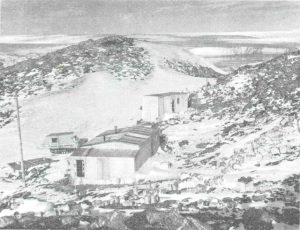 Thanks to Olivier F6EPN, we have rebuilt the history of Marret Base which, so far, has been forgotten by our careful searches of old and new Antarctic Bases and settlements.
Thanks to Olivier F6EPN, we have rebuilt the history of Marret Base which, so far, has been forgotten by our careful searches of old and new Antarctic Bases and settlements.
The reference WAP FRA-11 to Marret Base issued now, fills a gap in the WAP Directory.
Here we are:
After two successive wintering at the Port-Martin station, 66°49’06” South, 141°24’02” East, WAP FRA-Ø7 , a small Base has been built on Petrels Island to a few hundred meters only to the Emperor Penguins rookerie, and was occupied for two winters, during which time the coastal islands were explored and ground control astrofixes observed with astro-labes and theodolites. 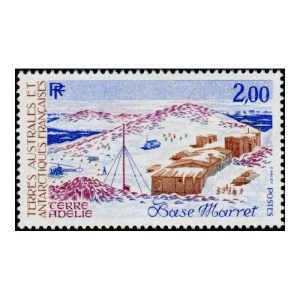
Seven people wintered there in 1952-1953 under the direction of Mario Marret. In January 1952, the French Antarctic Expedition , enlarged the hut on Petrel Island to serve as the new base site.
It looks like FB8YY (and maybe also FB8AX, Marret’s callsign) did operate from Marret Station on that dates, as reported on a list present on LNDX website (see: FB8YY.XLS (lesnouvellesdx.fr) TNX F6AJA
.
The wooden buildings known as “Base Marret or Cabane Marret”, 66°40’South, 140°1’ East, has been designated a Historic site or Monument (HSM 47), following a proposal by France to the Antarctic Treaty Consultative Meeting.
The iron cross on the north-east headland of Petrels island, is dedicated as a memorial to André Prud’homme, head meteorologist on the third International Geophysical Year expedition, who disappeared during a blizzard on 7 January 1959; it has similarly been designated a Historic Site or Monument (HSM 48)
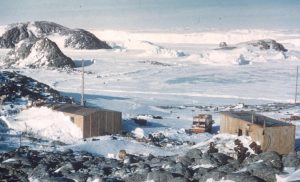 Today, the Marret building on Petrel Island, restored by the 36th French Mission, is always present and many are wintering them which made there some scrapers, evenings melted pancakes and others, on the traces of Prevost, Marret and the others…
Today, the Marret building on Petrel Island, restored by the 36th French Mission, is always present and many are wintering them which made there some scrapers, evenings melted pancakes and others, on the traces of Prevost, Marret and the others…
Petrels Island is now the site of Dumond d’Urville Station at 66°39’46” South, 140°00’05” East (WAP FRA-Ø1).
Summing up, this is the true story:
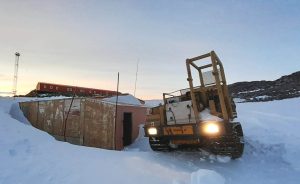 Base Marret (aka Cabane Marret), new issued WAP FRA-11 at 66°40’12” South, 140°1’ 0” East. After the fire at Port Martin Base in January 1952, Mario Marret, the expedition leader and six men; Robert Dovers – geodesy, Jackie Duhamel – constructions, Georges Lepineux – radio, Jean Rivolier – doctor, Jean Prevost – ornithology, Roger Vincent – mechanic, volunteered to spend the winter on the Pointe Géologie archipelago. It is therefore this “Hut”, which has become the first Base on the island of Petrels, that the Terre Adelie 5th Expedition wintered from January 17, 1952 through January 20, 1953 in precarious conditions.
Base Marret (aka Cabane Marret), new issued WAP FRA-11 at 66°40’12” South, 140°1’ 0” East. After the fire at Port Martin Base in January 1952, Mario Marret, the expedition leader and six men; Robert Dovers – geodesy, Jackie Duhamel – constructions, Georges Lepineux – radio, Jean Rivolier – doctor, Jean Prevost – ornithology, Roger Vincent – mechanic, volunteered to spend the winter on the Pointe Géologie archipelago. It is therefore this “Hut”, which has become the first Base on the island of Petrels, that the Terre Adelie 5th Expedition wintered from January 17, 1952 through January 20, 1953 in precarious conditions.
- Dumond D’Urville Station (aka DDU) WAP FRA-Ø1 at 66°39’46” South, 140°00’05” East was built and opened on January 12, 1956
 So, Marret 66°40’12” South, 140°1’ 0” East was already classified as Base before of DDU (66°39’46” South, 140°00’05” East) which was built and opened on January 12, 1956.
So, Marret 66°40’12” South, 140°1’ 0” East was already classified as Base before of DDU (66°39’46” South, 140°00’05” East) which was built and opened on January 12, 1956.
Today:
Considering that David Brunet F4FKT-FT4YM has given permission to operate from inside of the Old Marret Base making a consistent number of QSOs (the picture prove his presence & activity), it becomes logical to 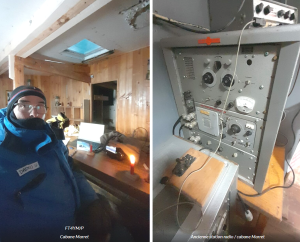 confirm that FT4YM/P operating from a building of Marret Base be eligible as WAP FRA-11.
confirm that FT4YM/P operating from a building of Marret Base be eligible as WAP FRA-11.
Congrats to David FT4YM, to Mehdi F5PFP and to all the French Hams who did help David to reach such a good goal
TNX F6EPN (aka Spratley Woody) for his precious help.
.
.
Credit and reference to:
Official blog of the Adélie Land district in Antarctica – TAAF: Marret Hut (terreadelie-antarctique.blogspot.com)
and to:
https://terreadelie-antarctique.blogspot.com/2021/05/petite-histoire-de-la-radio-hf-dumont.html?fbclid=IwAR0_e4kdW1ZqVZ-n-u3BxfX2XQzSLvIjkeRFWgrEy-fY-vEN7by6f8wM0zY
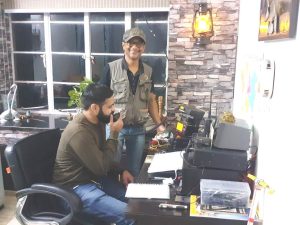 27 years old Eng. Sarabjeet Singh Chhabra (Sunny), is actually at Cape Town waiting the flight to Novo Runway (WAP MNB-Ø6) and from there, to Maitri Base (WAP IND-Ø3). Sunny will be down South for about a year as part of the 42nd Indian Scientific Expedition to Antarctica.
27 years old Eng. Sarabjeet Singh Chhabra (Sunny), is actually at Cape Town waiting the flight to Novo Runway (WAP MNB-Ø6) and from there, to Maitri Base (WAP IND-Ø3). Sunny will be down South for about a year as part of the 42nd Indian Scientific Expedition to Antarctica. Sunny thanks VU2MUE Sandeep Baruah from Vigyan Prasar for the 2 rigs to be used in Antarctica and VU3BPZ, Antarctic veteran and good friend that has always been a guidance for his Antarctica journey
Sunny thanks VU2MUE Sandeep Baruah from Vigyan Prasar for the 2 rigs to be used in Antarctica and VU3BPZ, Antarctic veteran and good friend that has always been a guidance for his Antarctica journey
 The Hut is around 25 square meters and is located about 3,2 kilometers from Troll Station (72°00’S, 2°32’E). The use of this small recreational Hut at Vassdalen about 40 min from Troll, was approved by the Norwegian Ministry of Climate and Environment. It is heated by a kerosene (Jet A-1) stove. The transport is mainly carried out with snow mobiles on a well-known route for the visitors and calculated to 50 days a year with 2 guests on each visit.
The Hut is around 25 square meters and is located about 3,2 kilometers from Troll Station (72°00’S, 2°32’E). The use of this small recreational Hut at Vassdalen about 40 min from Troll, was approved by the Norwegian Ministry of Climate and Environment. It is heated by a kerosene (Jet A-1) stove. The transport is mainly carried out with snow mobiles on a well-known route for the visitors and calculated to 50 days a year with 2 guests on each visit.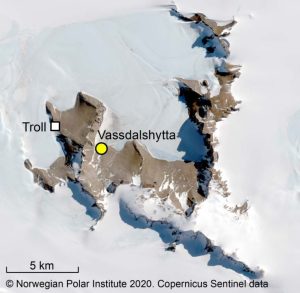 Skiing, hiking in the mountains, running and shorter trips with snowmobiles and Band wagons are typical activities for the personnel at Troll Station. According to the information, Vassdalsbua Hut is in use since 2018. After a visit the garbage is transported back to environmental station at Troll. Sometimes, researchers spend severl days at Vassdalsbua field Hut, collecting variety of soil and water samples for study
Skiing, hiking in the mountains, running and shorter trips with snowmobiles and Band wagons are typical activities for the personnel at Troll Station. According to the information, Vassdalsbua Hut is in use since 2018. After a visit the garbage is transported back to environmental station at Troll. Sometimes, researchers spend severl days at Vassdalsbua field Hut, collecting variety of soil and water samples for study
 After the joint venture with the Hams of Russian Robinson Club (RRC) in the celebrations of the 200th anniversary of the discovery of Antarctica, WAP proposes a new friendship adventure, undertaking jointly in honor of the Italian Air Force (
After the joint venture with the Hams of Russian Robinson Club (RRC) in the celebrations of the 200th anniversary of the discovery of Antarctica, WAP proposes a new friendship adventure, undertaking jointly in honor of the Italian Air Force ( Additional purpose, is to share what Nations and Organizations are doing to protect this still non contaminated corner of the world, to share WW a message of peace .
Additional purpose, is to share what Nations and Organizations are doing to protect this still non contaminated corner of the world, to share WW a message of peace . The conference held on last November 11, is an instance of integration and exchange between researchers who have developed or are currently developing Antarctic Science activities. The idea is to share the progress, difficulties and eventual solutions that have arisen in the course of the projects. The purpose of the meeting, is yo allow generating and consolidating research collaborations, as well as evaluating the work completed with a perspective view of activities to eventually continue.
The conference held on last November 11, is an instance of integration and exchange between researchers who have developed or are currently developing Antarctic Science activities. The idea is to share the progress, difficulties and eventual solutions that have arisen in the course of the projects. The purpose of the meeting, is yo allow generating and consolidating research collaborations, as well as evaluating the work completed with a perspective view of activities to eventually continue.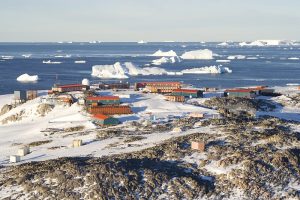 Scientists and technical staff at the French Base Dumont d’Urville,
Scientists and technical staff at the French Base Dumont d’Urville,  Thanks to Olivier F6EPN, we have rebuilt the history of Marret Base which, so far, has been forgotten by our careful searches of old and new Antarctic Bases and settlements.
Thanks to Olivier F6EPN, we have rebuilt the history of Marret Base which, so far, has been forgotten by our careful searches of old and new Antarctic Bases and settlements.
 Today, the Marret building on Petrel Island, restored by the 36th French Mission, is always present and many are wintering them which made there some scrapers, evenings melted pancakes and others, on the traces of Prevost, Marret and the others…
Today, the Marret building on Petrel Island, restored by the 36th French Mission, is always present and many are wintering them which made there some scrapers, evenings melted pancakes and others, on the traces of Prevost, Marret and the others… Base Marret (aka Cabane Marret), new issued
Base Marret (aka Cabane Marret), new issued  So, Marret 66°40’12” South, 140°1’ 0” East was already classified as Base before of DDU (66°39’46” South, 140°00’05” East) which was built and opened on January 12, 1956.
So, Marret 66°40’12” South, 140°1’ 0” East was already classified as Base before of DDU (66°39’46” South, 140°00’05” East) which was built and opened on January 12, 1956. confirm that FT4YM/P operating from a building of Marret Base be eligible as WAP FRA-11.
confirm that FT4YM/P operating from a building of Marret Base be eligible as WAP FRA-11. Dr. Volker Strecke DL8JDX did participate the Polar Salon Liberec at Liberec City, Czech Republic.
Dr. Volker Strecke DL8JDX did participate the Polar Salon Liberec at Liberec City, Czech Republic.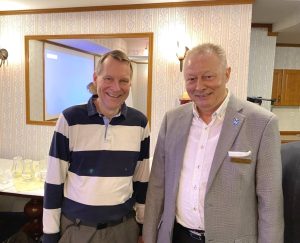
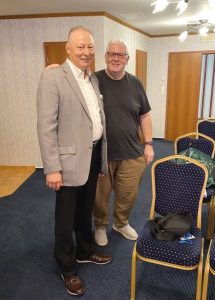 The Photo at left, shows Dr. Voker Strecke (
The Photo at left, shows Dr. Voker Strecke (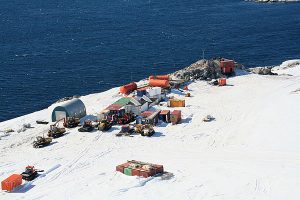 Robert Guillard-Cap Prud’homme Station at 66°41’31″South, 139°53’46″East, is a French-Italian station managed by the French Polar Institute Paul-Emile Victor (
Robert Guillard-Cap Prud’homme Station at 66°41’31″South, 139°53’46″East, is a French-Italian station managed by the French Polar Institute Paul-Emile Victor (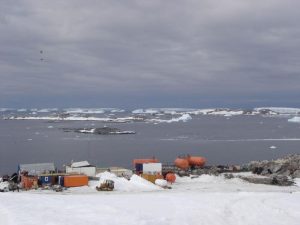 The joint French-Italian Station Robert Guillard-Cape Prud’homme (
The joint French-Italian Station Robert Guillard-Cape Prud’homme (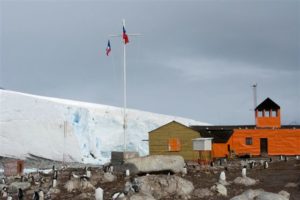 The Chilean scientific Base, Gabriel Gonzalez Videla, is located at 64° 49′ 24″ South, 62° 51′ 7″ West on the Danco Coast at the north end of the “Antarctic” Peninsula. The Base is situated on two small islands: Lomnitz and Dott (approx. 18,000 square metres), The two islands are separated by a very narrow channel partly filled with morainal material. The northern island is named Isla “Lomnitz” and the southern island, Isla “Dott”. Between the islands and the mainland is a 90-metre channel, which is dry at low tide. This channel and the eastern shores of the islands are covered by till.
The Chilean scientific Base, Gabriel Gonzalez Videla, is located at 64° 49′ 24″ South, 62° 51′ 7″ West on the Danco Coast at the north end of the “Antarctic” Peninsula. The Base is situated on two small islands: Lomnitz and Dott (approx. 18,000 square metres), The two islands are separated by a very narrow channel partly filled with morainal material. The northern island is named Isla “Lomnitz” and the southern island, Isla “Dott”. Between the islands and the mainland is a 90-metre channel, which is dry at low tide. This channel and the eastern shores of the islands are covered by till.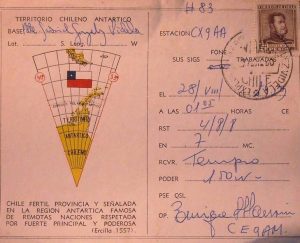 Isla Util, a small island in the Gerlache Strait, lies 7 miles north of the base.
Isla Util, a small island in the Gerlache Strait, lies 7 miles north of the base.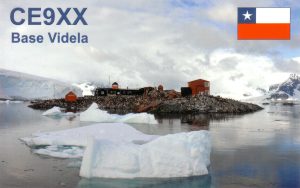 thin sections of the rocks collected were studied subsequently at the University of Wisconsin.
thin sections of the rocks collected were studied subsequently at the University of Wisconsin.